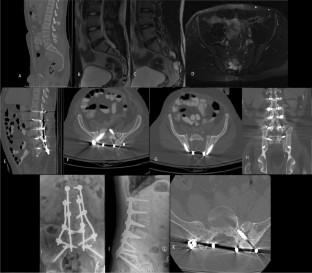European Spine Journal ( IF 2.6 ) Pub Date : 2022-09-03 , DOI: 10.1007/s00586-022-07363-z Ahmed Cherry 1 , Colby Oitment 2 , Jay Wunder 1, 3 , Peter Ferguson 1, 3 , Raja Rampersaud 1, 4

|
Purpose
Primary sacral tumors are rare, representing fewer than 7% of spinal neoplasms. Following total sacrectomy, lumbopelvic instrumentation and fusion carries a high risk of non-union with no current consensus on fixation techniques to augment bony defects. We aim to describe the outcome of a reconstruction technique following total sacrectomy whereby lumbopelvic shortening is performed and the posterior pelvic ring is compressed to enable contact with the native L5 vertebra.
Methods
Retrospective chart review of 2 patients with 2 and 7 years post-operative follow-up. A review of hospital records including clinical assessments, complications, pathology and imaging reports.
Results
Patient 1 was a 17-years-old male with recurrent sacral chondrosarcoma, who presented with lumbosacral neuropathic pain and radiculopathy after failed intralesional surgery. Patient 2 was a 51-years-old male with chronic low back pain caused by a large low-grade chondroid sacral chordoma. Reconstruction technique involved mobilizing the L5 vertebra into the pelvis and pelvic ring closure to obtain host-bone-to-bone contact, eliminating the need for alternative grafts. Post-operative complications included superficial abdominal wound drainage, lower limb DVT, pulmonary emboli and deep pelvic infection. Serial CT scans demonstrated bony fusion in both patients. Neither patients had evidence of tumor recurrence and were able to ambulate at recent follow-up. Imaging demonstrated changed acetabular version of − 4.6/− 8.1 and − 14.4/− 14.8 (patient 1/2, R/L, respectively).
Conclusion
Primary lumbopelvic shortening represents an alternative local autograft reconstructive technique for management of large sacral defects following total sacrectomy. This technique obviates the additional morbidity and surgical cost associated with the use of previously described techniques.
中文翻译:

腰骨盆缩短和局部宿主骨对宿主骨重建:全骶骨切除术后腰骨盆融合的手术方法
目的
原发性骶骨肿瘤很少见,占脊柱肿瘤的不到 7%。在全骶骨切除术后,腰骨盆内固定和融合具有很高的不愈合风险,目前对于增加骨缺损的固定技术还没有达成共识。我们的目的是描述全骶骨切除术后重建技术的结果,即进行腰骨盆缩短并压缩后骨盆环以使其能够与原生 L5 椎骨接触。
方法
对 2 名术后随访 2 年和 7 年的患者进行回顾性图表审查。审查医院记录,包括临床评估、并发症、病理学和影像学报告。
结果
患者 1 是一名 17 岁男性,患有复发性骶骨软骨肉瘤,在病灶内手术失败后出现腰骶部神经性疼痛和神经根病。患者 2 是一名 51 岁的男性,患有由大的低级别软骨样骶骨脊索瘤引起的慢性腰痛。重建技术涉及将 L5 椎骨移入骨盆和骨盆环闭合以获得宿主骨与骨的接触,从而无需替代移植物。术后并发症包括浅表腹部伤口引流、下肢DVT、肺栓塞和盆腔深部感染。系列 CT 扫描显示两名患者均有骨融合。两名患者都没有肿瘤复发的证据,并且在最近的随访中都无法行走。成像显示改变的髋臼版本为 − 4.6/− 8.1 和 − 14.4/− 14.8(患者 1/2,
结论
原发性腰骨盆缩短代表了一种替代的局部自体移植重建技术,用于治疗全骶骨切除术后的大骶骨缺损。该技术避免了与使用先前描述的技术相关的额外发病率和手术费用。











































 京公网安备 11010802027423号
京公网安备 11010802027423号